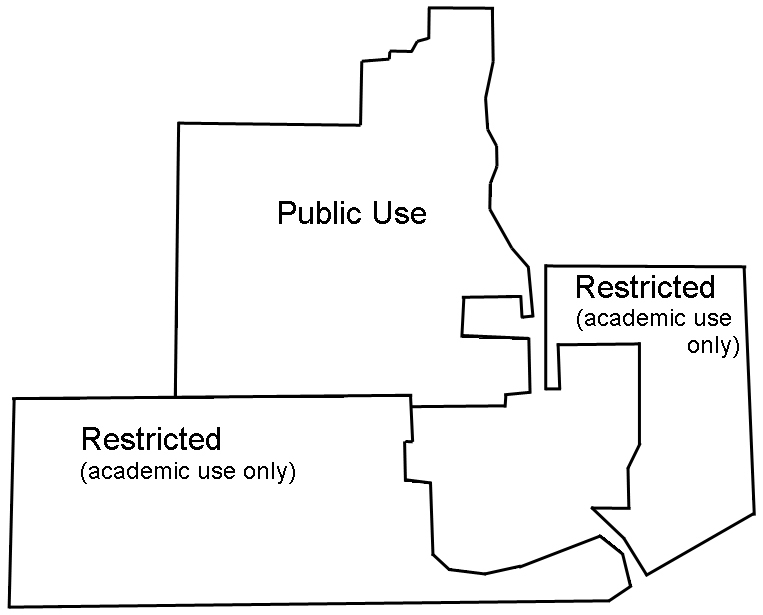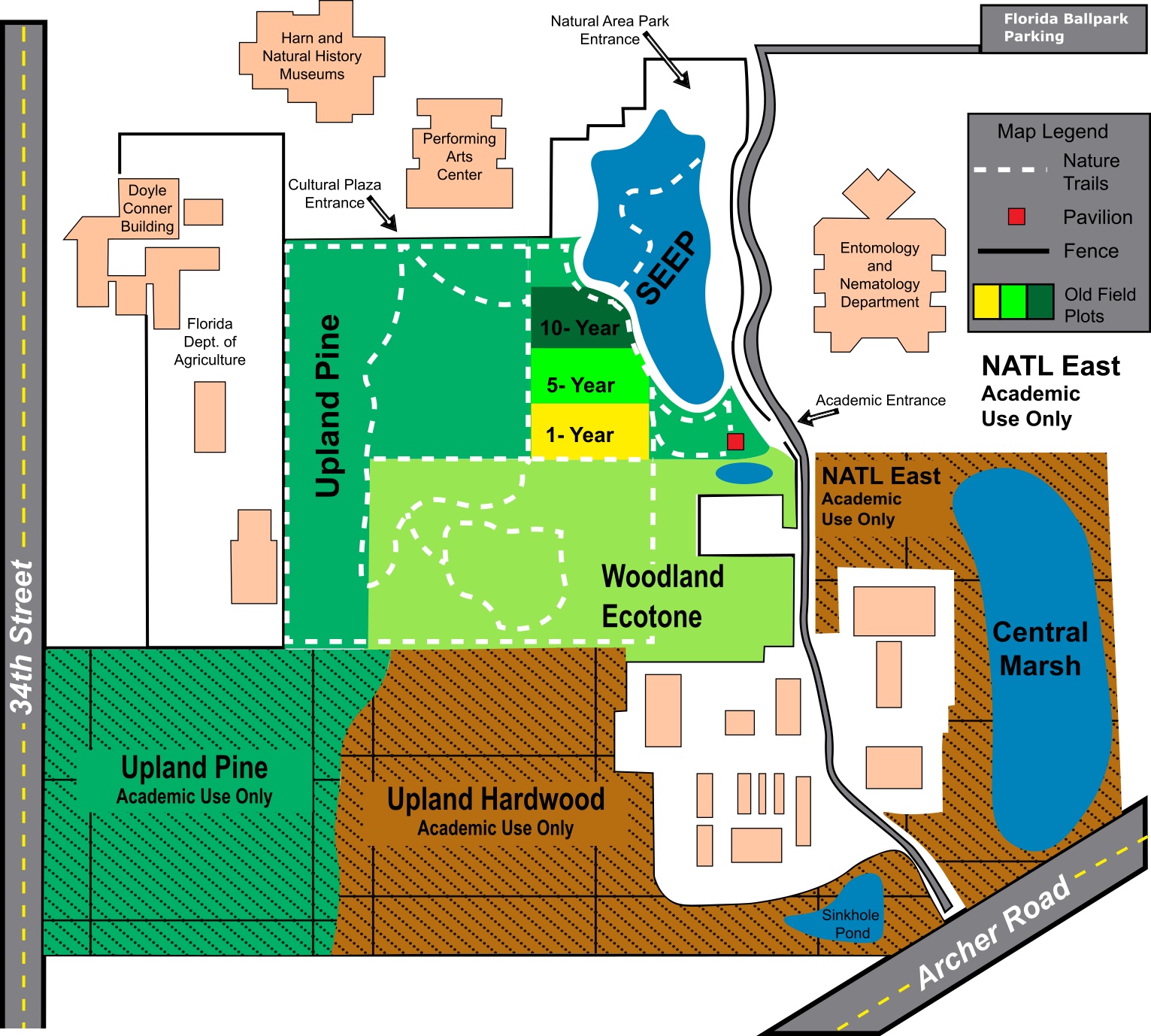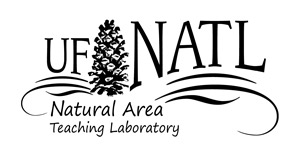| UF Academic Use | Public Use | Family Fun and K-12 Education |

Rules for Using NATL
General rules - Activities requiring notification - Activities requiring approval - Project Proposal Form - Restricted areas - Flags and equipment - Studying vertebrate animals - Projects in restricted areas
These guidelines for class activities and student projects in University of Florida's Natural Area Teaching Laboratory were adopted by the Natural Area Advisory Committee (NAAC) on 8 Dec 1995, modified on 1 April 1999, and edited to accommodate the addition of NATL-east in July 2005. In June 2009, the NATL Operations Committee developed a dog policy based on the principles spelled out below. Latest revision approved by NAAC and posted May 2013.
General rules (Back to Top)
- Activities should be in keeping with NATL’s purpose—i.e., to help students and the public learn about ecology and biotic diversity.
- Activities should maintain, rather than significantly diminish, the usefulness of the area for its purpose.
- Many come to NATL to ID animals based on their sounds so please keep noise to a minimum.
- Visitors are encouraged to remove trash but are asked to not disturb marking stakes and flags.
- NATL is part of the University of Florida main campus, and campus rules should be observed including the Tobacco-Free Campus policy.
- Insect collecting is permitted in NATL however we ask that log-rolling entomologists in NATL follow this additional guidance.
- Bike racks are located in the Natural Area Park and near the pavilion. Please note that racks are secure for temporary parking only and bikes should not be left overnight. Visitors are asked to refrain from riding bikes on the trails.
- Visitors without a UF parking decal may park at the coin-metered spots in front of the Florida Museum of Natural History. Paid parking is also available in front of the Harn Museum. On weekends, holidays, and after 3:30 pm on weekdays, parking decals are not required in the Entomology building parking lot. Please do not park on the side of Surge Area Drive.
Types of activities requiring notification (Back to Top)
- Activities in the public area that are evident in the absence of the user (e.g., flags and stakes marking plots or transects) require NATL notification. A brief description of the activity should be emailed to us. Projects of this nature may also require a proposal and approval.
Types of activities requiring a proposal and approval (Back to Top)
The following types of activities must be pre-approved by the Natural Area Advisory Committee and require a completed NATL Project Proposal Form:
- Activities that permanently alter the ecology of the area.
- Activities that may interfere with others using NATL.
- Activities that may diminish the usefulness of NATL for teaching about ecology and biotic diversity.
- Activities in restricted areas (see map below) that last longer than one semester and that are evident in the absence of the user (e.g., flags and stakes marking plots or transects).
NATL's restricted areas (Back to Top)
The part of NATL-west that lies south of Division Trail and all of NATL-east (see map) are designated for academic use only. The public is excluded, but students, faculty, and classes have free access for academic purposes.
The reason access is restricted in these areas is to make them more suitable for student research projects that require equipment and markers to remain undisturbed. Consequently, those using the areas are asked to avoid sites where projects are ongoing as evidenced by equipment and markers that identify the project. In no case should markers or equipment be taken or moved.
If you wish to leave equipment or markers in any part of NATL for more than a single semester, you must describe your project and the Natural Area Advisory Committee must approve it.

The northern portion of NATL is for public as well as academic use.
The rest of NATL is for academic use only.

This map shows ecosystems for the outline map above.
Flags, stakes, and other equipment (Back to Top)
Flags, stakes, and other equipment may be temporarily left on site if NATL is notified. All equipment should display the owner’s name, contact information (a Gatorlink- @ufl.edu- email address should be used to ensure NATL users are affiliated with UF), and date of placement. If equipment is lacking such information it may be removed without notice. In any case, the person who leaves flags, stakes, and equipment should remove them as soon as their purpose is completed.
Studying vertebrate animals in NATL (Back to Top)
- Studies in NATL that require prolonged disturbance, handling or trapping of fish, amphibians, reptiles, birds and/or mammals and are done as part of a numbered UF course other than for research require approval of the NATL Operations Committee but not of IACUC.
(If the committee has doubts as to whether a proposed project comes under the teaching exception of if the project needs IACUC approval, it will notify the proposer and table the proposal until IACUC approves the project or grants a waiver.) - Studies in NATL that require prolonged disturbance, handling or trapping of any vertebrate and are done as part of any research project require approval of both the NATL Operations Committee and of IACUC.
- To propose a project in NATL, please complete and return this form.
Note: Without IACUC approval, vertebrate research at UF facilities cannot be used as part of a thesis or dissertation or be accepted for publication in many journals.
Procedures for projects in NATL's restricted areas (Back to Top)
Each project in NATL-west south of Division Trail or in NATL-east must have a faculty sponsor (unless the proposer is a faculty member or other professional researcher).
A proposal must be prepared for each project. The proposal should be brief but must include:
- Project proposer (name, department, e-mail address, university and home phone numbers).
- Faculty sponsor (name, department, e-mail address).
- Description of project (title, objective, justification, methods and schedule, nature of final report) [Make this part concise.]
- Expected and possible impacts on NATL (flags, markers or equipment that will be left unattended, where [use NATL's grid] and when they will be left, what initials or name will identify them; temporary or permanent changes in NATL ecology that are expected or might occur).
Once the proposer of the project has his/her sponsor's approval of the proposal, it should be sent by e-mail to the Advisory Committee chair. If the proposal meets the criteria above, the chair will forward it to the Advisory Committee for approval, disapproval, or required revisions. Researchers conducting approved projects in NATL are required to provide the the Advisory Committee chair with a project abstract and photos representing the research being conducted in NATL.
In most cases, NAAC action on a proposal should be completed in one week.
When marked plots or transects are established, their locations should be plotted on a NATL grid map and sent by campus mail to the chair of the Natural Area Advisory Committee.
If a project lasts longer than one year, a one-page e-mailed progress report is due on each anniversary date of the project's approval. The report should describe progress and any changes or additions to the original proposal.
When the project is completed, a final report must be submitted in a form that can be posted on NATL's website. (This would presumably be the same information as in a hardcopy report of the project. If it is a thesis or dissertation, NATL's website should be able to link to UF's site for theses and dissertations.)
These procedures approved by the Natural Area Advisory Committee on 19 March 1998, slightly revised 12 October 2001, and modified to include NATL-east in July 2005; Latest revision approved by NAAC and posted May 2013.


